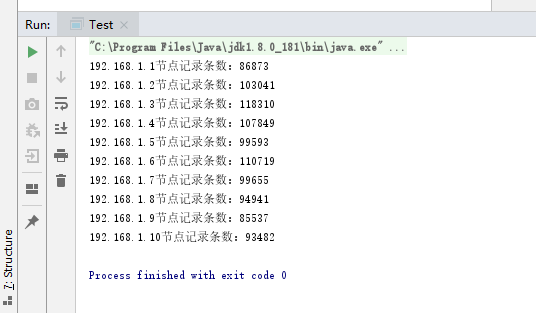架构师训练营 - 第五周作业
发布于: 2020 年 07 月 08 日
作业一:
用你熟悉的编程语言实现一致性 hash 算法。
编写测试用例测试这个算法,测试 100 万 KV 数据,10 个服务器节点的情况下,计算这些 KV 数据在服务器上分布数量的标准差,以评估算法的存储负载不均衡性。
public class HashFunction {
public Integer hash(String key) {
final int p = 16777619; int hash = (int)2166136261L; for (int i = 0; i < key.length(); i++) hash = (hash ^ key.charAt(i)) * p; hash += hash << 13; hash ^= hash >> 7; hash += hash << 3; hash ^= hash >> 17; hash += hash << 5;
// 如果算出来的值为负数则取其绝对值 if (hash < 0) hash = Math.abs(hash); return hash; }}
public class Node {
private String ip; private String name;
public Node(String ip, String name) { this.ip = ip; this.name = name; }
public String getIp() { return ip; }
public void setIp(String ip) { this.ip = ip; }
public String getName() { return name; }
public void setName(String name) { this.name = name; }}
import java.util.Collection;import java.util.SortedMap;import java.util.TreeMap;
public class ConsistentHash {
private final HashFunction hashFunction; private final int numberOfReplicas; private final SortedMap<Integer, Node> circle = new TreeMap<>();
public ConsistentHash(HashFunction hashFunction, int numberOfReplicas, Collection<Node> nodes) { this.hashFunction = hashFunction; this.numberOfReplicas = numberOfReplicas;
for (Node node : nodes) { add(node); } }
public void add(Node node) { for (int i = 0; i < this.numberOfReplicas; i++) { circle.put(this.hashFunction.hash(node.getIp() + i), node); } }
public void remove(Node node) { for (int i = 0; i < this.numberOfReplicas; i++) { circle.remove(this.hashFunction.hash(node.getIp() + i)); } }
public Node get(String key) { if (circle.isEmpty()) { return null; } Integer hash = hashFunction.hash(key); if (!circle.containsKey(hash)) { SortedMap<Integer, Node> tailMap = circle.tailMap(hash); hash = tailMap.isEmpty() ? circle.firstKey() : tailMap.firstKey(); } return circle.get(hash); }}
import java.util.*;
public class Test {
private static final String IP_PREFIX = "192.168.1."; public static void main(String[] args) { Map<String, Integer> map = new HashMap<String, Integer>(); HashFunction hashFunction = new HashFunction(); List<Node> realNodes = new ArrayList<>(); for (int i = 1; i <= 10; i++) { map.put(IP_PREFIX + i, 0); Node node = new Node(IP_PREFIX + i, "node" + i); realNodes.add(node); } ConsistentHash consistentHash = new ConsistentHash(hashFunction,100,realNodes); for (int i = 0; i < 1000000; i++) { String data = UUID.randomUUID().toString() + i; Node node = consistentHash.get(data); map.put(node.getIp(), map.get(node.getIp()) + 1); }
for (int i = 1; i <= 10; i++) { System.out.println(IP_PREFIX + i + "节点记录条数:" + map.get("192.168.1." + i)); } }}复制代码

划线
评论
复制
发布于: 2020 年 07 月 08 日阅读数: 51
版权声明: 本文为 InfoQ 作者【teslə】的原创文章。
原文链接:【http://xie.infoq.cn/article/317f9baa7881da865d27e14fb】。未经作者许可,禁止转载。
teslə
关注
还未添加个人签名 2018.08.09 加入
还未添加个人简介












评论